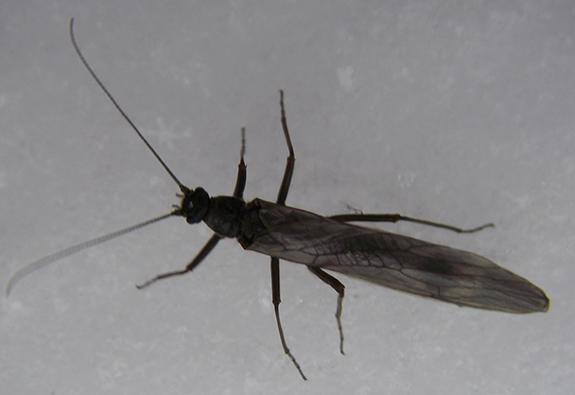This warm weather cracked the wintery spell releasing spring fever among trout fishers. It’s not only the fishers that are responding by stalking along streams in search of trout. It is also the adult winter stoneflies that are crawling from streams onto melting snowbanks. They are certainly not in search of trout, but are seeking mates, as it is their mating season. The distance traveled, in some cases 50 to 100 feet, is considerable given the small size of the insect. They migrate from the streams in large numbers creating quite an arresting view, an unexpected cadre of bugs marching in a defined manner following a route directly away from the stream.
It seems like a counterintuitive behavior to be searching for mates by traveling away from their origin in streams. Mother nature though has a way for solving mysteries and in this case communication among the migrants is the solution. The Taeniopteryx winter stonefly drum or beat the tip of their abdomen on branches, reeds and stiff grass stems of the vegetation the winter stoneflies crawl over. The drumming causes sufficient vibrations detectable by females from males signaling their intention to mate. Females respond with drumming of their own and following a series of drumming exchanges males and females reach a common goal and mating happens.
This rather astounding feat is occurring all over Central Wisconsin on snowbanks surrounding trout streams. As you probably imagine it is most commonly observed on sun warmed afternoons. The dark brown and almost black coloration of the adult is conducive to absorbing solar energy thereby it could be said that the sun heats up the situation. While both sexes are winged as adults, it is the female that takes flight to return to the stream to lay her eggs on the water surface. The female flutters in a zig-zag manner across the stream surface, an action that draws trout to rise from the depths and give chase.
The numbers of returning females maybe low; however, the action of egg laying is more than adequate that trout focus on this behavior and become vulnerable to being caught by fishers. Ross Mueller, in his essential book “Fly Fishing Midwestern Spring Creeks”, describes an effective #15-17 size black dry fly pattern along with fishing suggestions that mimic the female egg laying fluttering movements.
The larval stage of winter stoneflies is also fishable, especially nearing the time when both male and female larvae move to the shallower sections of streams in preparation to crawling up the stream bank. Such movement in swiftly flowing water can dislodge and tumble the larvae into the current where waiting trout readily snap them up. Those larvae that make it to the stream bank quickly split open their larval exoskeleton, freeing the adult stonefly to emerge leaving behind a wraith-likeness skin.
Whether fishing or enjoying the unique nature of our local trout streams there are wonders enough for all of us to experience and marvel at as we patiently observe late wintery months before the real spring arrives.


